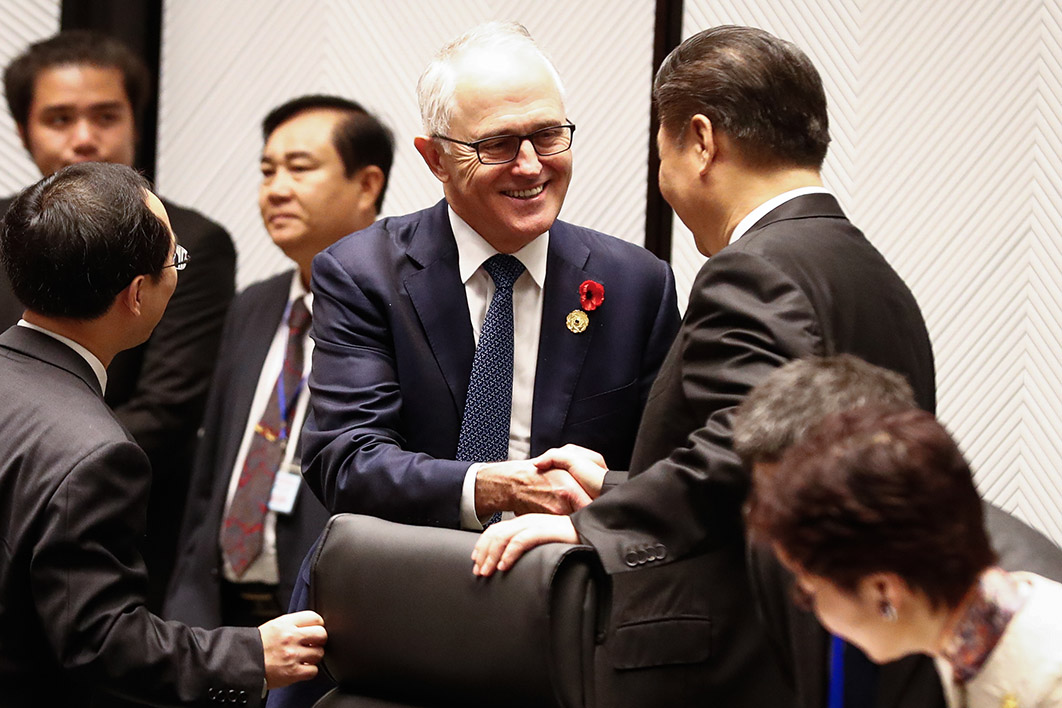China’s Grand Strategy and Australia’s Future in the New Global Order
By Geoff Raby | Melbourne University Publishing | $34.99 | 232 pages
These are early days, but it is already apparent that Joe Biden’s approach to China poses more difficult choices for Australia than did Donald Trump’s. The Trump administration was awkward enough, launching a bilateral trade negotiation that forced China to buy more US farm products — and therefore less from other countries, including Australia. By contrast, the Biden administration wants Australia to be an important part of a regional coalition against China in both the security and economic realms, an approach that will find many friends in Australia but obstruct our hopes of resuming a durable trading relationship.
Creating a regional anti-China coalition may be in America’s interest, and the Biden administration, like its predecessors, certainly thinks of China as America’s number one strategic competitor. But it is not necessarily in Australia’s interest. China’s continuing economic success is good for Australia; policies designed to obstruct that success are not. If America succeeds in hindering China’s technological progress, for example, one of the losers will be Australia.
This is not just because more than a third of Australia’s goods exports go to China. It is largely because China accounts for a little more than half the output of the entire East Asia and Pacific region. It is by far the largest economy in a highly integrated economic region of which Australia is a part, a region that accounts for three-quarters of Australia’s goods exports and nearly two-thirds of its goods imports. In Australian planning, China’s regional predominance should be assumed to persist and perhaps increase. It will continue to be the indispensable economic partner for most countries in the region, including Australia. This is the region in which Australia finds itself, now and forever.
In the Trump administration’s trade war, prime minister Scott Morrison declared Australia a neutral. Since the president wasn’t keenly seeking Australia’s support, that position was uncontroversial. With the new administration, neutrality is unlikely to be enough.
The best guide to the Biden administration’s approach to China was made public by its top Indo-Pacific official, Kurt Campbell, in early January. In a co-authored Foreign Affairs piece, Campbell wrote that China’s deployment of new weaponry (and the creation of weapons platforms in the South China Sea) increases the vulnerability of US aircraft carriers near China’s coasts. The US needs instead to deploy more long-range conventional missiles, unmanned aircraft, submarines and high-speed strike weapons.
In deploying these weapons, Campbell writes, the US should work with regional allies to disperse US forces around the region. This ambition fits well with Australia’s long-range submarines program and willingness to host American military facilities. At the same time, Campbell suggests, military deterrence of China should be enhanced by expanding defence arrangements between the US, Japan, Australia and India — the “Quad.”
But military arrangements will not be enough. Campbell believes the US should join or initiate China-related discussions among its friends in relation to “supply chains, investment regimes, and trade agreements.” He assumes the US will continue its “managed decoupling” from China. Tellingly, he complains of the recent EU–China investment agreement because it will “complicate a unified transatlantic approach under the Biden administration.” Separate negotiations between American allies and China will evidently be discouraged.
A “unified” approach to China by Europe and America will be complemented by a wider coalition, including Asian regional partners. Campbell favourably instances the D-10, proposed by Britain, which would include the G7 of big rich democracies plus Australia, India and South Korea. These coalitions, writes Campbell, “will be most urgent for questions of trade, technology, supply chains, and standards.” Under this proposal, Australia would be a member of a regional coalition whose members will presumably be discouraged by the Americans from making bilateral deals with China.
Australia will have no problem with joining discussions about China, sharing information or even attempting to agree a common list of complaints. But there is every problem with a joint negotiation with China, which is what Campbell appears to want. Such negotiations would inevitably be under US leadership, and pursue US priorities. Australia could find itself pressing China to open up to Alphabet, Amazon and Facebook, while at the same time complaining that these corporations pay little tax on their Australian revenues, have too much market power, and retain vast quantities of information about Australians. It could find itself pressing for a freely floating renminbi and a complete deregulation of China’s financial system, though Australian regulators may have strong reservations about both. It could find itself part of a coalition to retard China’s advanced industries, an objective directly contrary to Australian economic interests.
Other than the emphasis on coalitions instead of unilateral action, the Biden administration’s approach is similar to his predecessor’s. In a National Security Council document declassified and released as the Trump administration was leaving office, the US was determined to “maintain US strategic primacy in the Indo-Pacific region and promote a liberal economic order while preventing China from establishing new, illiberal spheres of influence and cultivating areas of cooperation to promote regional peace and prosperity.” The Biden administration would no doubt agree.
The document also asserted that China “seeks to dominate cutting-edge technologies, including artificial intelligence and bio-genetics, and harness them in the service of authoritarianism. Chinese dominance in these technologies would pose profound challenges to free societies.” Again, the Biden administration probably has the same view. Matthew Pottinger, who wrote the document when he was on staff at the National Security Council, wanted to “strengthen the capabilities and will of regional allies,” including Australia. The aim was to “align our Indo-Pacific strategy with those of Australia, India and Japan.” Campbell says much the same.
The Biden administration’s resolve to create anti-China coalitions coincides with a low point in Australia’s bilateral relationship with China. Before the pandemic, the increasing antagonism between America and China bothered Australia, though it was way beyond Australia’s capacity to influence. It threatened to change the global economy in a way we might find inimical to our interests. By contrast, the recent direct antagonism between Australia and China poses problems of much greater immediacy and severity.
These are problems only Australia and China can deal with. They are beyond spin, beyond culture wars, beyond the help of great friends. Resolving them depends almost entirely on us, and on the professionalism, skill and judgement of the Australian government and its advisers. They could well be the gravest problems the Australians involved have ever met, or are likely to meet. They may influence Australia’s destiny for decades. This is a test of the seriousness of purpose and the quality of Australia’s political leadership. Incidental to others, it is central to us.
Geoff Raby’s insightful new book is directly pertinent to these acute difficulties in Australian foreign policy. Raby, a former Australian ambassador to China, is a longstanding critic of the drift in Australian attitudes towards China. “Australia’s policy of the past four years, of joining the US in competition with China,” he announces, “has been a strategic miscalculation” damaging to Australia not only in China but also in the region. Australia “will be taken less seriously and be less respected by regional partners,” he argues, “if it is not able to manage its relations with China.”
Though his title promises to explain China’s “grand strategy” and Australia’s future in the “new global order,” Raby is too experienced, too worldly-wise, too much of a realist, to believe that China has acquired a grand strategy very different from the old, or that a “new” global order has actually emerged.
He discusses in some detail the Belt and Road Initiative, which is often supposed to be the key component in China’s program to create a new global order. He points out that its achievements so far have not contributed much to China’s security. It is certainly an expensive initiative, one taken very seriously by Beijing, one that has on the whole been helpful to the recipient countries, but it has not augmented China’s power, either soft or hard, and it has not created a new world order. Nor is it likely to.
What has changed is that brief period of American hegemony following the collapse of the Soviet Union, which ended with the disaster of the second invasion of Iraq, the concurrent rise of China, and the shattering of America’s domestic political consensus on the rocks of extreme and widening inequality. The world has become multipolar once again — with two leading powers competing for the fidelity of the rest.
In Raby’s account, China’s grand strategy is conditioned today, as ever, by neighbouring and regional powers that have sometimes been enemies and sometimes friends, all of them formidable. Russia, India and Japan are the biggest of them, and among smaller neighbours China has also been in fights with Vietnam, Taiwan and South Korea.
Another enduring element of China’s grand strategy, as Raby points out, has been sustaining its territorial unity. It has long had to deal with separatist forces in Xingjian, in the Tibetan regions of southwest China, in Hong Kong and of course in Taiwan. When these imperatives are provisioned, China has little left over for exerting force beyond its own region. Thus, says Raby, China is unlikely to become a “regional hegemon” or pose “any threat to Australia’s security.”
The Biden administration not only wants to sustain the Quad as an alliance to contain China. It also wants to expand it, presumably by adding South Korea. Raby’s chapter on the Quad group is particularly pertinent and illuminating. Its explication requires the kind of analytic skills Raby has developed in his diplomatic career — undogmatic, attuned to nuance and informed by an understanding of each party’s interests and intentions. Though presented by Canberra as a dialogue among Indo-Pacific democracies, the Quad doesn’t include South Korea and the Southeast Asian democracies. It is clearly intended — at least by Australia and the US — as a military formation directed against China. Indeed, this is the way it was described by former US secretary of state Mike Pompeo.
As Raby points out, the Quad’s military value to its participants is in fact very limited. India and Japan have distinct issues with China that often do not overlap with the interests of other members. And while the US, India and Japan are formidable military powers, Australia is not. What the Quad represents, Raby suggests, is an attempt by the US and perhaps Japan to draw India into a military understanding against China. As a nuclear weapons state with a large army and a formidable navy, India doesn’t need this understanding, and probably neither wants nor would reliably abide by it. Australia’s eager support for the Quad alienates China but gathers no redeeming security advantage.
More than three years have passed since China permitted high-level contact with Australia. Over the past year it has imposed penalties on Australian exports of barley, wine, beef, coal and wheat — penalties usually ascribed to Australia’s March 2020 advocacy of an independent inquiry into the Chinese origins of the pandemic. In fact, they are more probably related to Australia’s prominent public role in not only refusing Huawei access to Australia’s telecommunications market but also advocating that Britain, India, Europe and for that matter the United States also exclude the company.
To a realist like Raby, no simple or easy response exists to Australia’s China problem, or its companion US problem. Australia cannot and will not abandon its future in a region economically dominated by China. Nor will it abandon its long security relationship with the US. Indeed, both a strong economic relationship with China and a strong security relationship with the US suit Australia well. The same combination suits South Korea, Japan and much of Southeast Asia. The policy job is to sustain the relationships when they are in conflict.
To that end, Raby offers a series of sensible principles to guide Australia’s response. Rather than being a flag-waver for the US, Australia should work harder on coalitions with like-minded regional countries — including Japan, Korea and especially governments in Southeast Asia — to clear a path between the competing pressures of the two great powers. It should be guided by a clear-headed identification of national interest rather than traditional links or kinship with the US, or humanitarian impulses or cultural affinities. Foreign policy should be carried out with discipline and professionalism, premised on a recognition that Australia’s interests are different from those of the US and China. It is not a novel agenda and not an easy one, but of those on offer it is the one that may work. •




